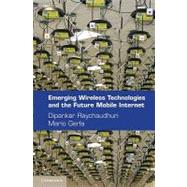
Note: Supplemental materials are not guaranteed with Rental or Used book purchases.
Purchase Benefits
Looking to rent a book? Rent Emerging Wireless Technologies and the Future Mobile Internet [ISBN: 9780521116466] for the semester, quarter, and short term or search our site for other textbooks by Edited by Dipankar Raychaudhuri , Mario Gerla. Renting a textbook can save you up to 90% from the cost of buying.
| Contributors | p. ix |
| Foreword | p. xi |
| Acknowledgments | p. xiii |
| Introduction | p. 1 |
| Background | p. 1 |
| Wireless Technology Roadmap | p. 2 |
| Wireless Networking Scenarios | p. 4 |
| Classifying Wireless Networking Scenarios | p. 10 |
| Future Network Requirements | p. 14 |
| Discussion | p. 17 |
| References | p. 18 |
| Next-Generation Wireless Standards and Their Integration with the Internet | p. 19 |
| Technology and Service Trends of Emerging Wireless Standards | p. 20 |
| Radio Technologies in Next-Generation Wireless Standards | p. 22 |
| Spectrum Management and Cognitive Radio Networks | p. 27 |
| All IP Mobile Networks | p. 29 |
| Mobility and Vertical Handover | p. 34 |
| Multihop Wireless Networks | p. 40 |
| Concluding Remarks | p. 51 |
| References | p. 51 |
| Ad Hoc and Mesh Network Protocols and Their Integration with the Internet | p. 54 |
| Introduction and Motivation | p. 54 |
| Network Architecture | p. 55 |
| Protocol Design | p. 58 |
| Cross-Layer Adaptive Mechanisms | p. 75 |
| Integration with the Internet | p. 84 |
| Conclusion | p. 86 |
| References | p. 86 |
| Opportunistic Delivery Services and Delay-Tolerant Networks | p. 92 |
| Introduction | p. 92 |
| Design Principles | p. 94 |
| Alternative Architectures | p. 96 |
| Converged Architecture | p. 108 |
| Concluding Remarks | p. 122 |
| References | p. 122 |
| Sensor Networks Architectures arid Protocols | p. 125 |
| Introduction | p. 125 |
| Link Layer Protocols | p. 126 |
| Tree-Based Routing | p. 132 |
| Dissemination | p. 135 |
| Reliable Transport | p. 139 |
| Support Protocols | p. 142 |
| Cross-Layer Concerns | p. 145 |
| The Emergence of IP | p. 147 |
| Sensor Networks and the Future Internet | p. 148 |
| Conclusions | p. 150 |
| References | p. 151 |
| Network Services for Mobile Participatory Sensing | p. 154 |
| Mobile Participatory Sensing Vision | p. 154 |
| Context Inference and Coordination | p. 158 |
| Data Attestation and credibility | p. 166 |
| Privacy | p. 169 |
| Implications for the Future Internet | p. 173 |
| Conclusions | p. 174 |
| Acknowledgments | p. 174 |
| References | p. 174 |
| Supporting Cognitive Radio Network Protocols on Software-Defined Radios | p. 178 |
| Introduction | p. 178 |
| Software-Defined Radio Architecture and Challenges | p. 180 |
| Core Cognitive Radio and MAC Functions | p. 183 |
| Split Functionality Architecture | p. 185 |
| Evaluating the Split-Functionality Approach for Cognitive Radio Networks | p. 187 |
| MAC-Layer Evaluation | p. 194 |
| Related Work | p. 198 |
| Conclusions | p. 199 |
| References | p. 200 |
| Vehicular Networks: Applications, Protocols, and Testbeds | p. 201 |
| Introduction | p. 202 |
| Vehicular Network and Application | p. 204 |
| Enabling Protocols | p. 216 |
| The Role of the Infrastructure: MobiMESH and GLS | p. 225 |
| Vehicular Testbeds | p. 229 |
| Conclusions | p. 237 |
| References | p. 238 |
| Opening Up the Last Frontiers for Securing the Future Wireless Internet | p. 242 |
| Security Challenges Facing the Future Wireless Internet | p. 243 |
| The Final Frontier: Introducing the Physical into Security | p. 244 |
| Platform and Device-Level Assurance | p. 246 |
| Location as an Enabler for Security Services | p. 253 |
| Using the Physical Layer to Enhance Security | p. 272 |
| Concluding Remarks | p. 278 |
| References | p. 279 |
| Experimental Systems for Next-Generation Wireless Networking | p. 283 |
| Introduction | p. 283 |
| Future Wireless Networking Testbeds: Requirements and Challenges | p. 286 |
| Existing Wireless Testbeds | p. 291 |
| Global Environment for Network Innovations (GENI) | p. 300 |
| Concluding Remarks | p. 308 |
| References | p. 309 |
| Concluding Remarks | p. 312 |
| Table of Contents provided by Ingram. All Rights Reserved. |
The New copy of this book will include any supplemental materials advertised. Please check the title of the book to determine if it should include any access cards, study guides, lab manuals, CDs, etc.
The Used, Rental and eBook copies of this book are not guaranteed to include any supplemental materials. Typically, only the book itself is included. This is true even if the title states it includes any access cards, study guides, lab manuals, CDs, etc.